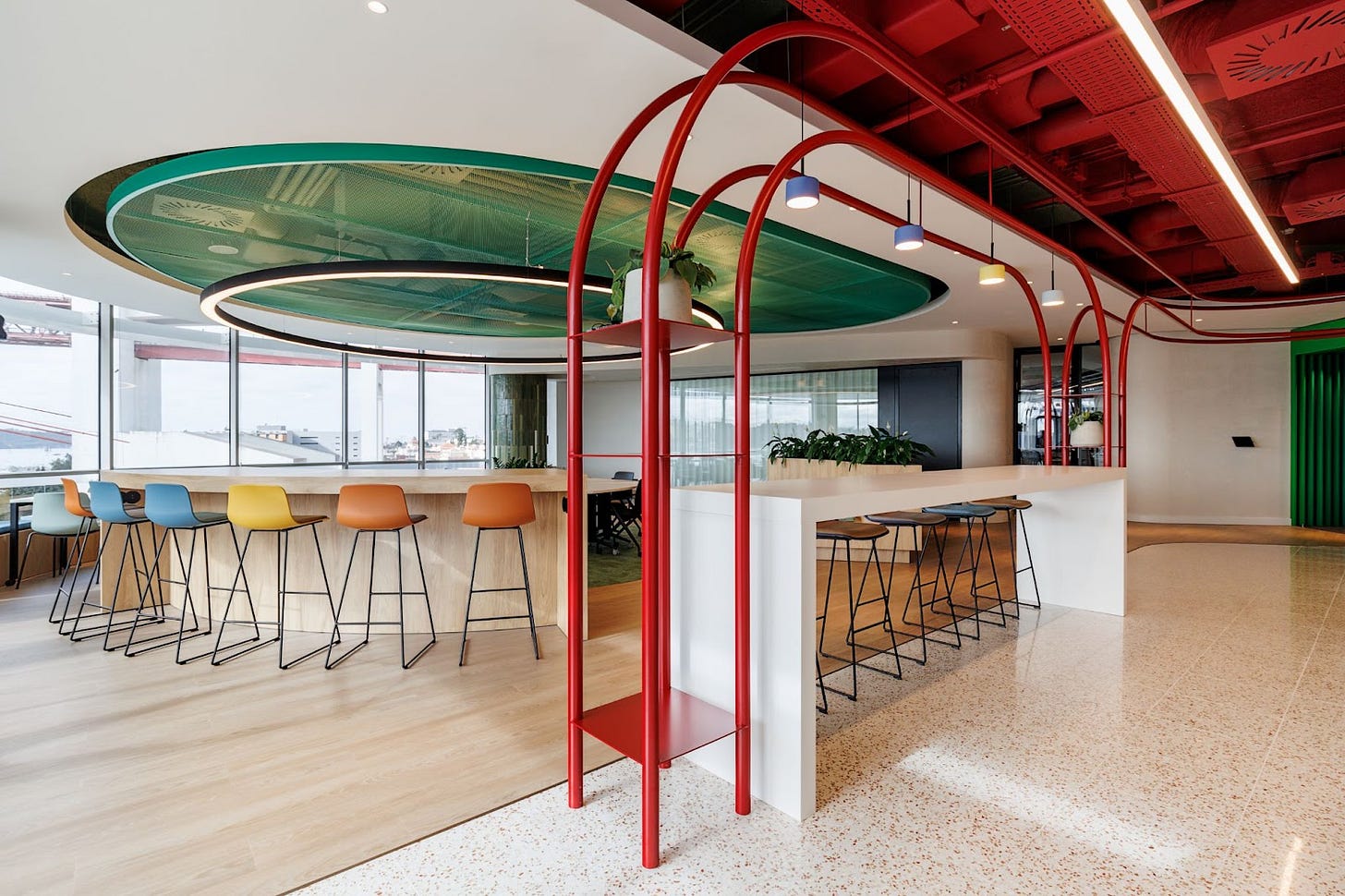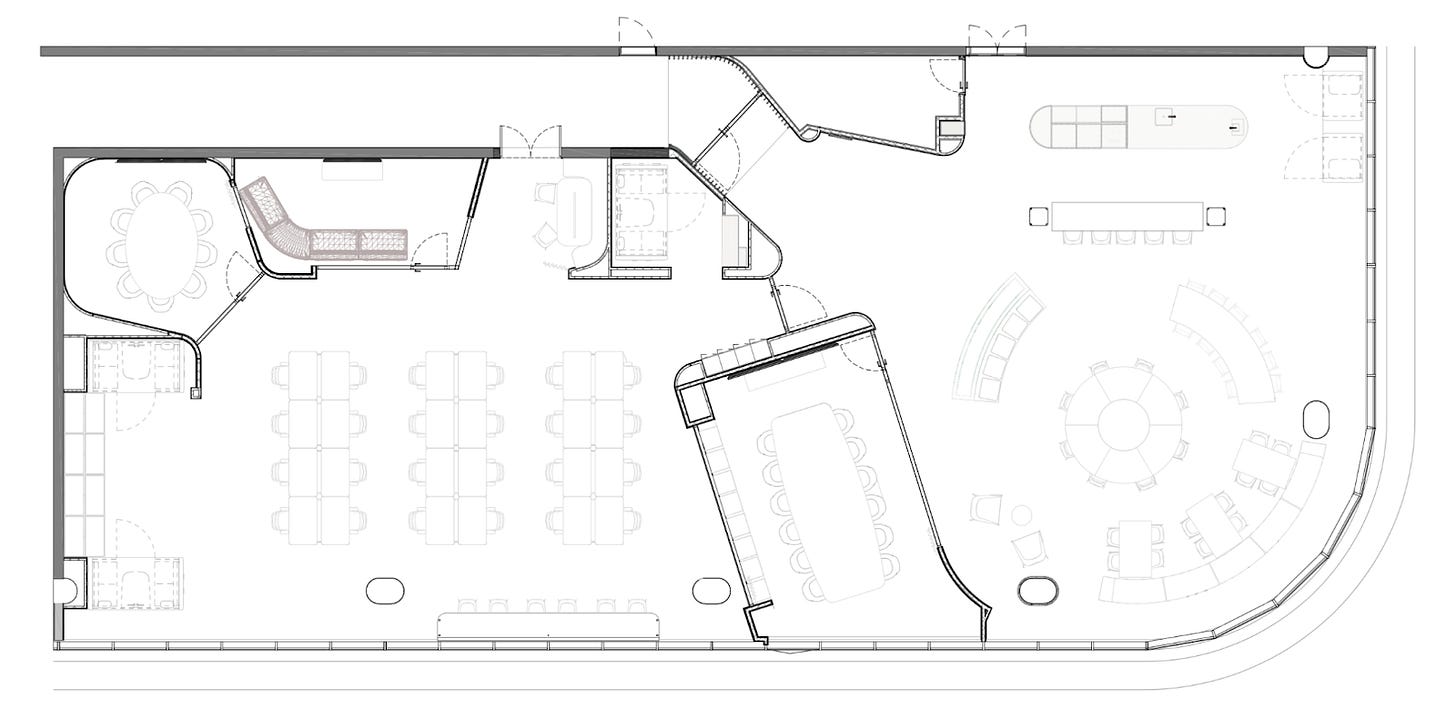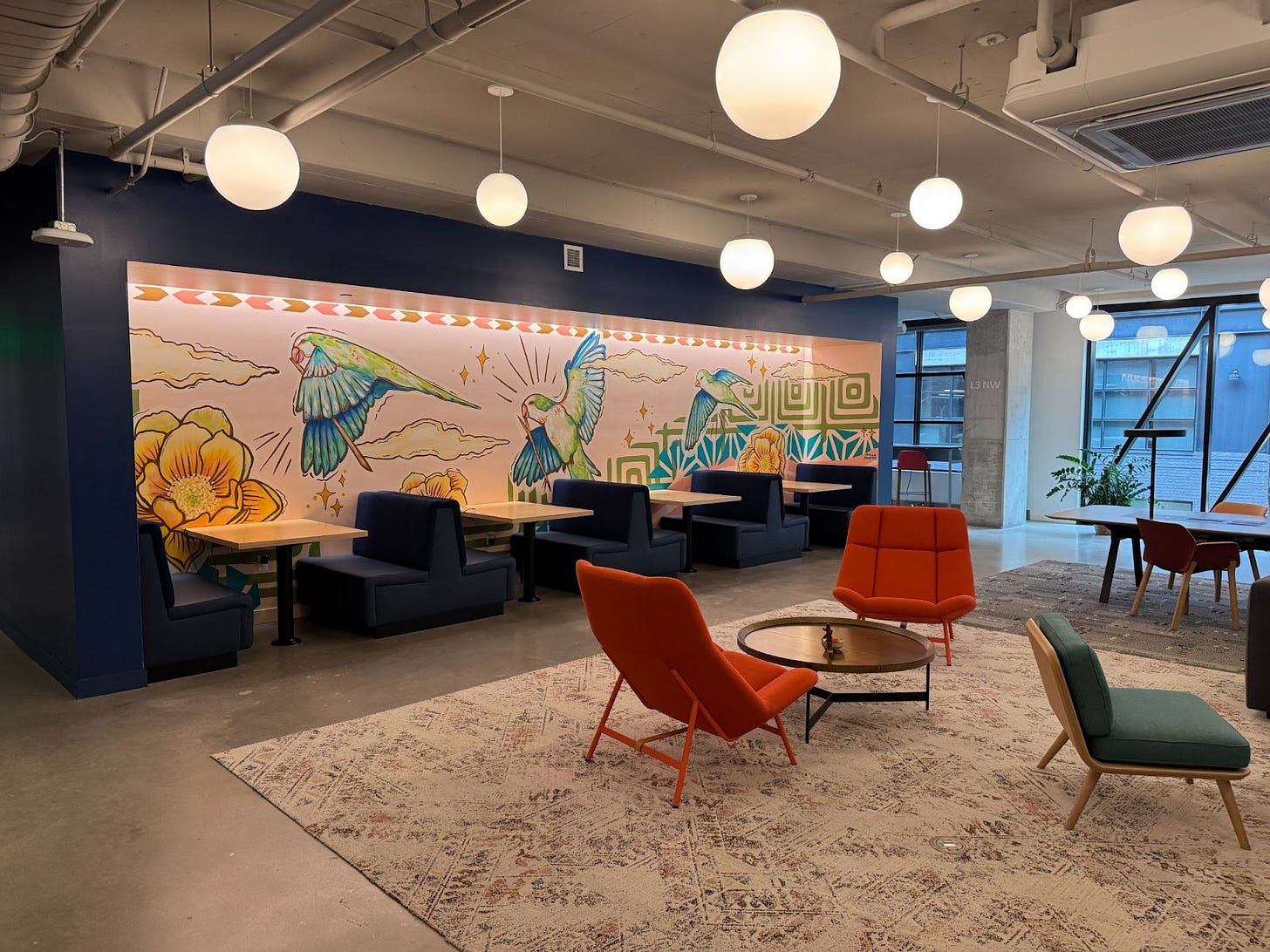From Facilities to Facilitation: The Great Workplace Reset
PagerDuty and Atlassian: Building Workplaces That Amplify Teams
Workplace teams, and their leaders, have had to evolve faster than any other function in the corporate world. The leaders in this space have fascinating stories about their journey from facilities management to workplace experience design, and facilitation of great team-building events.
They're taking learning-based approaches, experimenting with solutions, and measuring what actually works rather than relying on rote rules. Meanwhile, the laggards often aren't there by choice: many are held hostage by executive indecision or nostalgia for workplace models that, frankly, didn’t really exist.
Today’s column features an in-depth story from Pagerduty’s Workplace leadership team, past and present, as well as some brief notes from a visit to Atlassian’s Austin office – and some really handy links to related reading.
Looking for the latest on RTO trends? Check out The RTO Mirage
PagerDuty's Approach to the Distributed Workplace
In an era where office utilization still hovers below 40% nationwide, companies face a crucial challenge: how do you maintain effective workspaces without wasting resources on empty desks? PagerDuty’s Global Workplace Experience team, in partnership with the Culture & Strategy and Internal Comms, developed a strategic approach that offers valuable lessons for companies navigating this new landscape, leveraging smaller (and higher quality) leased spaces and flexible space providers.
The 80/20 Principle: Design for What You Actually Need
PagerDuty's approach to corporate real estate hinged on a pragmatic insight: design for how people actually use space, not how they might hypothetically use it.
The focus of the in-person portion of their hybrid strategy was to strengthen connections, drive innovation and accelerate learning, wherever PagerDuty employees might be located. PagerDuty’s teams are globally distributed so getting together as a team is a huge draw for employees.
"We adapted our space designs for the 80-20 rule, which is 80% of the time, meetings are 30 people or less," Adam Gallant, Director, Global Workplace Experience at PagerDuty, explained. "For that 20% where you have more than 30 people, it's more cost effective to go offsite, because typically those only happen once or twice a year."
This principle guided PagerDuty through a dramatic transformation of their workspace footprint. Their test case was in Toronto, where they reduced office space by more than 60% (from 27,000 square feet to just 8,500) and built out a new space that was fit for today’s needs:
Common area “hackable space” that could easily accommodate a 30 person team on-site, or by moving some flexible dividers or furniture expand to 60.
Individual desk locations for only 24 people, with additional flexible seating spaces, phone booths and smaller meeting rooms.
Great location, views and amenities that make going into the office comfortable and fun.
Gone are the rows of empty desks, replaced by a smaller space optimized for the actual patterns of use: primarily in-person meetings, collaborative sessions, and some heads-down space for individual work.
What happens when one of those “20%” events occur, like a massive all-hands when CEO Jennifer Tejada comes to town? They leverage an external venue or flexible space provider to find a spot that will work.
The Reality of Distributed Teams
PagerDuty's real estate strategy was shaped by three key realities that the majority of enterprise companies now face:
Teams are distributed: Many teams have managers and teammates who are spread out across locations, and that’s even more true for people whose work is primarily done in project teams.
Talent is everywhere: Like many firms, COVID opened up the potential to tap broader pools of talent.
Role-specific needs: Different functions have different in-person requirements, making one-size-fits-all approaches ineffective.
Instead of fighting these realities, PagerDuty embraced them, allowing each department to determine its own in-office cadence. The workplace team are focused on making the office "a magnet" for meaningful connection.
Learning and Expansion
The team expanded the concepts piloted in Toronto to other offices: “We have found a sweet spot – higher quality but smaller spaces that can accommodate the modules that we need: a flexible work cafe, 3 or 4 meeting rooms, space for a couple dozen desks and plenty of comfortable seating.”
Pagerduty Lisbon: common area space
In Lisbon, Portugal, learnings from Toronto allowed them to create great sound separation between the work cafe and other areas to create “quiet” versus social zones, for example. Locations like Lisbon have also become quite popular for the “onsite is the new offsite” desires of teams.
Pagerduty Lisbon: quiet zone separation
Overall, from Toronto forward, the changes at PagerDuty have resulted in higher quality environments for employees: better buildings, better locations and better designs. The quality of design, along with the variety of work settings that fit team collaboration needs, has resulted in “an office where people want to be, rather than one where they have to be."
Pagerduty Toronto: higher quality space, and great views
Pop-Up and Pop-In Programs: Supporting Communities Without Offices
One of the most innovative aspects of PagerDuty's approach was creating connection points for employees in cities without formal offices. This took two forms:
The PopUp Program
The Workplace Experience team would curate a one-day event in one of the cities, and bring everybody together for cross-functional connection, culture re-engagement, innovation and brainstorming sessions, and learning,
These events featured executive fireside chats, internal speakers and learning sessions, team dinners, and social activities that served as cross-functional networking opportunities.
The early participation of executives proved crucial for program sustainability: "When we were experimenting with the program, some of the executive team were able to participate in the early iterations of those events and were huge supporters.”
The PopIn Program
Building on the success of these company-organized events, PagerDuty later introduced a self-organizing option: "At the end of last year, we started what we called the PopIn program, which is just carving out some funds for each of those cities if they wanted to self-organize."
This democratized approach allowed local employees to organize their own volunteer events, team happy hours and ad-hoc workspace gatherings through a flexible workspace provider.
By centralizing the funding, PagerDuty removed the friction that often prevents these grassroots gatherings.
Both of these programs were often done in cities where PagerDuty never had an office. Instead of committing to longer-term contracts, they simply used on-demand providers to find high quality spaces.
Executives as Connection Catalysts
PagerDuty also leveraged executive travel strategically: "We started leveraging when executives were traveling for customer reasons or for investors or press... if there was an event happening, then we just map an employee-facing event around that."
This approach created meaningful connections for distributed and remote employees, maximized the impact of executive travel budgets and (most importantly) demonstrated leadership commitment to distributed teams.
Travel has become a broader theme as well, creating more need for Workplace teams to think of their role in hospitality. “We’re thinking about it more like a hotel would,” Adam noted. “People want to be greeted personally, and need support when they come into a new location.”
Results: Less Space, More Connection
The transformed approach delivered multiple benefits:
Significant cost savings: A reduction in the North American real estate footprint and costs allowed for PagerDuty to reallocate funding to other initiatives.
Improved utilization: Spaces felt vibrant and active, countering the empty echoes that face teams coming to space that’s 2-3X what’s needed today.
Broader engagement: Employees in cities without offices still felt connected to the company, without breaking the bank.
While some initial skeptics worried about desk availability, these concerns quickly dissipated as usage patterns evolved: "When people come in, they're usually there for a meeting. And so they're in the work cafe or they're in the boardroom or they're participating in a meeting and so they don't need the desk."
Key Takeaways for Leaders
PagerDuty's approach offers valuable lessons for companies rethinking their real estate strategy:
Design for actual usage patterns: Study how your space is actually used, not how you wish it were used. Allow functional flexibility in setting patterns and modularity where feasible.
Leverage flex providers: Instead of being locked into leases for underutilized space, combine leases with flexible office access for larger events and teams in broader locations.
Create connection beyond offices: Invest in bringing people together in cities without offices through structured programs.
Leverage executive presence: Align leadership travel with employee connection opportunities.
Start with a test case: PagerDuty piloted this approach in Toronto before expanding it to other locations like Atlanta, Lisbon and London.
As Adam put it: "We just didn't want to go back to having a sea of workstations that sit empty 60% of the time … if not more."
In an era of distributed work, this practical, employee-centered approach to corporate real estate might just be the blueprint many organizations need.
Atlassian: Expanding Workplace Leadership
Yesterday, I joined a great tour of Atlassian's Austin office, hosted by workplace leaders Rachel Reilly, Mark Cruth, and Ric Wang. While Atlassian operates as a distributed, remote-first company, they've proven that thoughtfully designed offices remain crucial, just for different reasons than before.
Their data shows that "Intentional Togetherness Gatherings"—planned collaborative sessions—drive a 27% boost in team engagement, significantly outperforming the serendipitous "water cooler moments" that return-to-office advocates often romanticize.
They've also recognized that office needs vary dramatically by location: Austin employees battle crushing commutes, New Yorkers crave personal space in a crowded city, and Bangalore teams need even more substantial workspace accommodations.
Atlassian’s Austin office; I loved the mural!
The company's investment in modular, flexible spaces is paying extraordinary dividends. Had they followed the traditional "Headcount × Growth × Density" formula for office planning, they'd require double their current square footage to accommodate today's number of employees. Instead, their adaptable approach allows them to reconfigure spaces as needs evolve: nothing is bolted down, everything can move.
Nothing's permanent: Atlassian's furniture can be reconfigured in hours, not months
Since opening in 2022, the Austin space has already been repurposed multiple times to accommodate increasing demand for team collaboration areas — a process that would typically involve months of construction and significant expense in traditional office designs.
For workplace professionals looking to dive deeper, I highly recommend Phil Kirschner's deep dive into Atlassian's workplace metrics with Annie Dean. Their framework for measuring space effectiveness rather than just utilization is a game-changer.
Building Your Modern Workplace Strategy: Where to Begin
The most successful workplace transformations I've observed share three key elements: they're data-informed but human-centered, they prioritize flexibility over rigid policies, and they engage employees as co-designers rather than subjects.
Whether you're leading workplace strategy or trying to influence decision-makers at your organization, start with these practical steps:
Measure what matters: Track collaboration patterns and team outcomes, not just badge swipes or desk occupancy.
Pilot before scaling: Test new concepts with volunteer teams who can help refine approaches before wider implementation.
Design for equity: Ensure your workplace strategy works for everyone, from caregivers to neurodivergent employees to those facing long commutes.
I've previously written about similar approaches at Allstate and Zillow, where workplace teams partnered closely with employees to create environments that balance business needs with human ones. The result? Better retention, stronger performance, and workplaces people actually want to use—by choice, not mandate.
What's your workplace team working on? Drop a comment (or hit reply!) and let me know—I'm always collecting case studies of organizations getting this right and supporting those wrestling to get there!









This is gold! An article that makes me feel I must send it to many-many peers and leaders lost in the endless (and fruitless) debate about office spaces. Thank you!